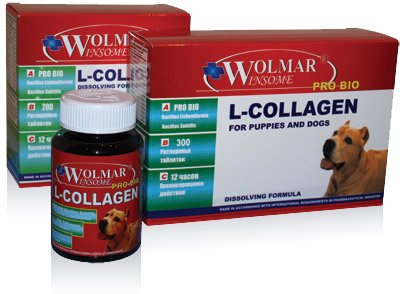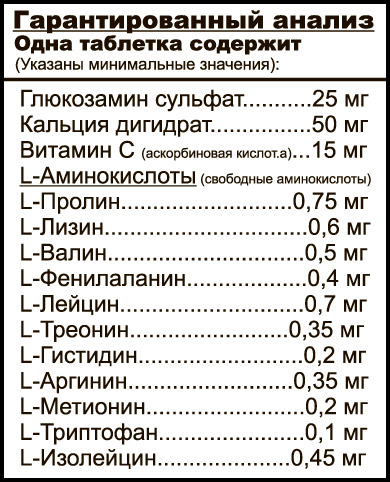Composition:
glucosamine sulfate, dihydrate calcium, ascorbic acid, protein-whey concentrate, protein isolate-whey concentrate, enzyme extracts of B. Subtilis (CH201/DSM5750), B. Licheniformis (CP200/DSM5749), MCC, SMC, calcium stearate, flavour.
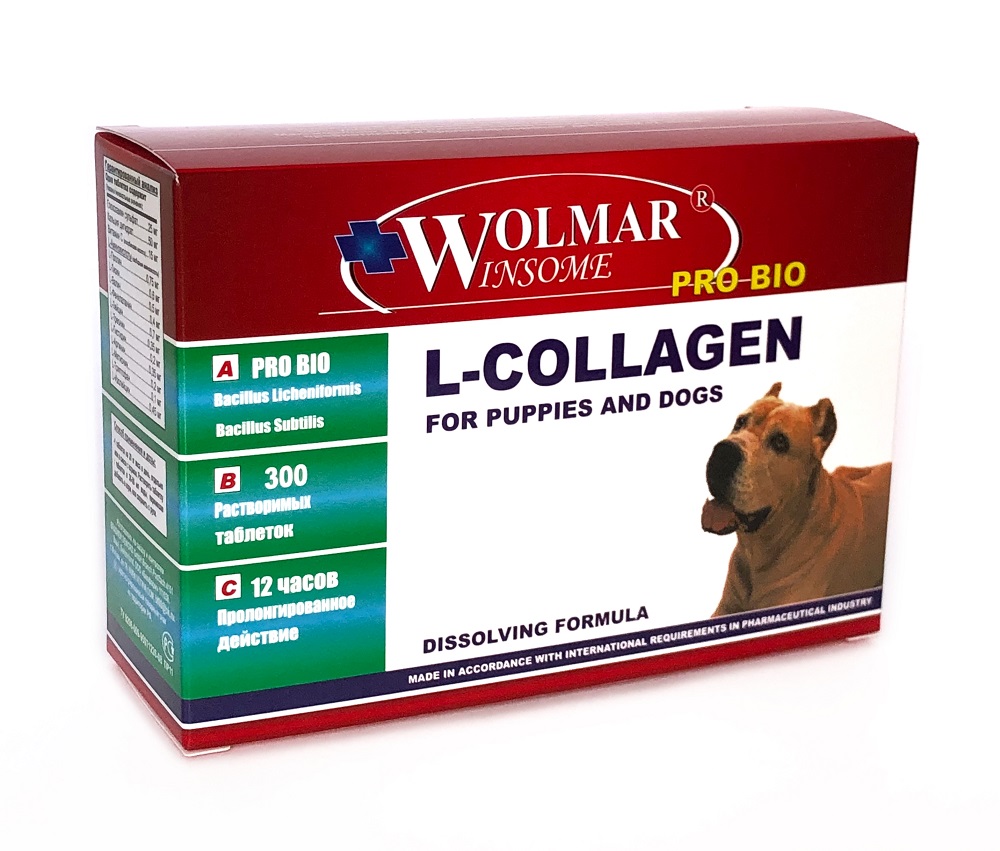
Additional information:
WOLMAR WINSOME® PRO BIO L-COLLAGEN contains L-crystalline amino acids, standardized by the American Pharmacopoeia (USP), from natural raw materials with maximum biological value of 100%. L-amino acids, most effective for biochemical processes in the body of the dog. L-amino acids ,(free, or unbound), represent the most pure form. They do not require digestion and are absorbed directly into the bloodstream. After ingestion absorbed very quickly and, as a rule, do not cause allergic reactions. Most amino acids exist in two forms, the chemical structure is one mirroring the other. They are called D - and L-forms, for example, D-cystine and L-cystine. D means dextra (right in Latin), and L - levo (respectively, left). These terms refer to the direction of rotation of the spiral, which is the chemical structure of this molecule. Proteins of animal and vegetable organisms created mainly L-forms of amino acids (with the exception of phenylalanine, which is D, L-forms). Amino acids are chemical structural units that make up proteins. They enter the body with food, then in the gastrointestinal tract after exposure to enzymes (pepsin, trypsin) are transformed into small peptides and amino acids, which are then absorbed into the blood and lymph. Any living organism is made up of proteins. Various forms of proteins involved in all processes occurring in living organisms. In the body of the dog proteins form muscles, ligaments, tendons and all the organs, proteins are members of fluids and bones. The enzymes and hormones that catalyze and regulate all the processes in the body, are also proteins. Amino acids are the "building blocks" used for protein synthesis. Every protein in the body is unique and for special purposes. Proteins are not interchangeable. They are synthesized in the body from amino acids, which are formed from the decomposition of proteins found in food.
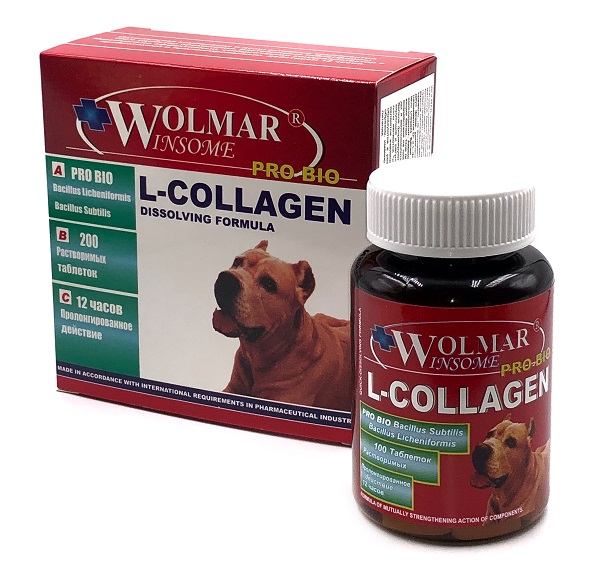
Thus, it is the amino acids, not proteins themselves are the most valuable nutrients. L-COLLAGEN contains L-crystalline amino acids, standardized by the American Pharmacopoeia (USP), from natural raw materials with maximum biological value of 100%. L-amino acids, most effective for biochemical processes in the body of the dog. L-amino acids, (free or unbound), represent the most pure form. They do not require digestion and are absorbed directly into the bloodstream. After ingestion absorbed very quickly and, as a rule, do not cause any allergic reactions. Most amino acids exist in two forms, the chemical structure is one mirroring the other. They are called D - and L-forms, for example, D-cystine and L-cystine. D means dextra (right in Latin), and L - levo (respectively, left). These terms refer to the direction of rotation of the spiral, which is the chemical structure of this molecule. Proteins of animal and vegetable organisms created mainly L-forms of amino acids (with the exception of phenylalanine, which is D, L-forms). Amino acids are chemical structural units that make up proteins. They enter the body with food, then in the gastrointestinal tract after exposure to enzymes (pepsin, trypsin) are transformed into small peptides and amino acids, which are then absorbed into the blood and lymph. Any living organism is made up of proteins. Various forms of proteins involved in all processes occurring in living organisms. In the body of the dog from protein forms muscles, ligaments, tendons and all the organs, proteins are members of fluids and bones. The enzymes and hormones that catalyze and regulate all the processes in the body, are also proteins. Amino acids are the "building blocks" used for protein synthesis. Every protein in the body is unique and there for special purposes. Proteins are not interchangeable. They are synthesized in the body from amino acids, which are formed from the decomposition of proteins found in food. Thus, it is the amino acids, not proteins themselves, that are the most valuable nutrients.

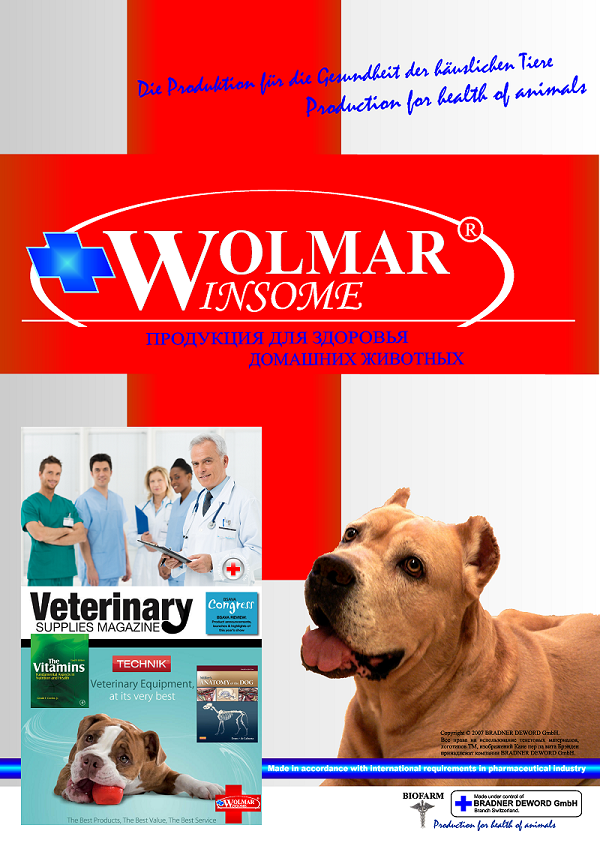
|





